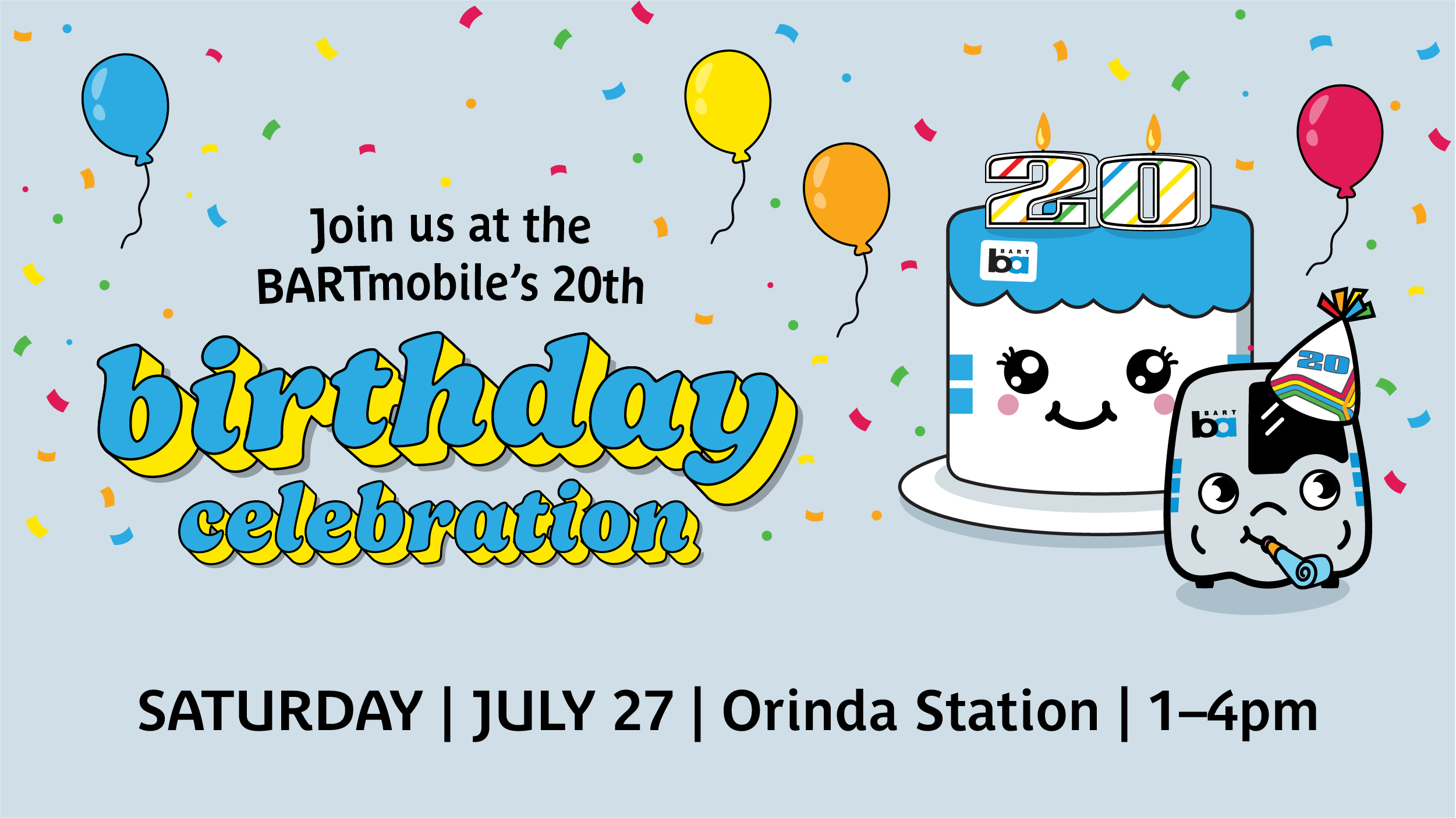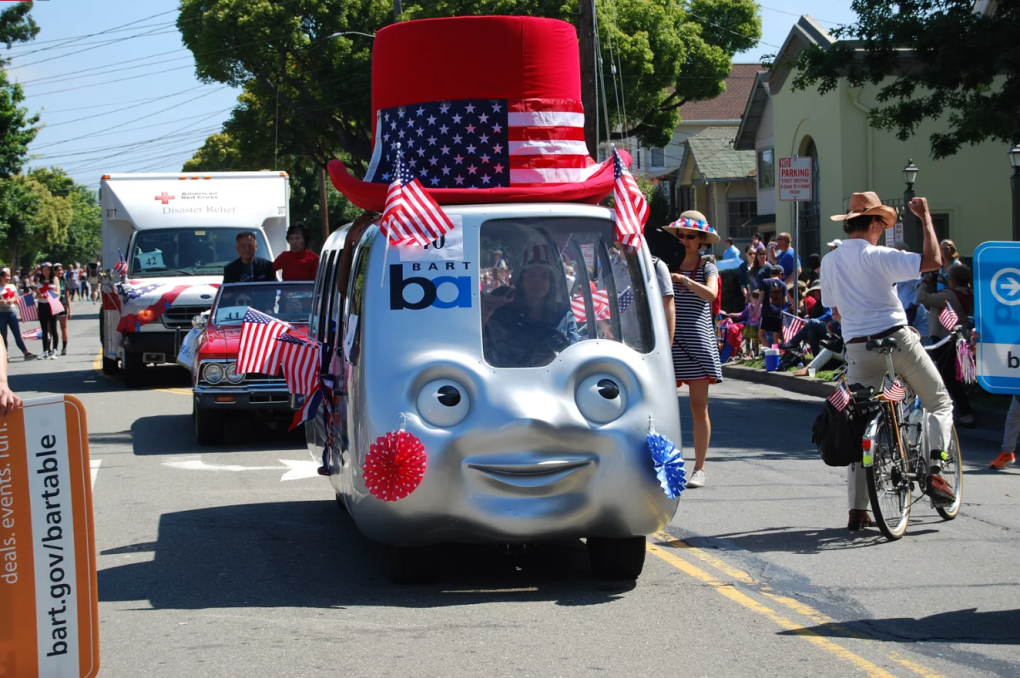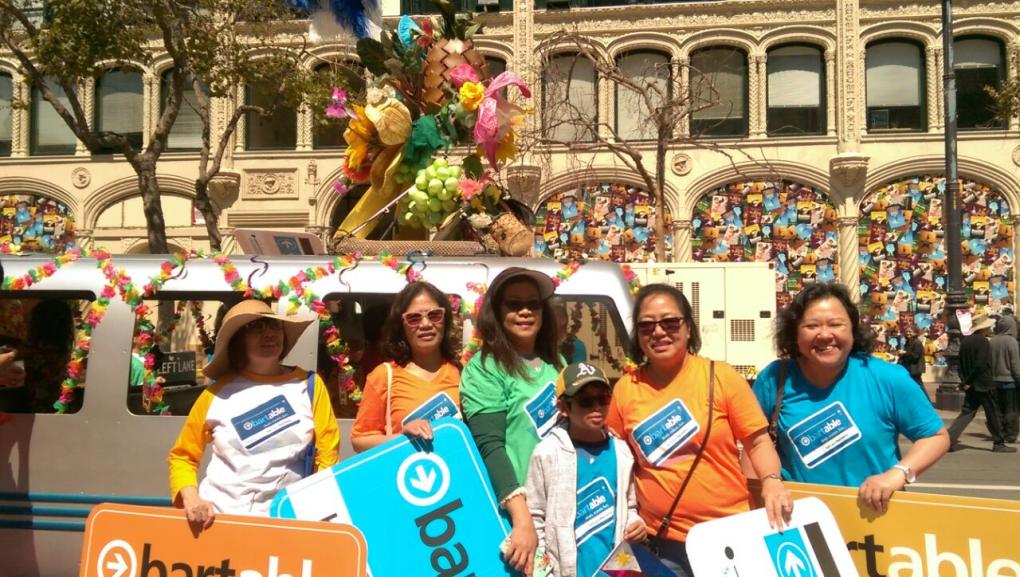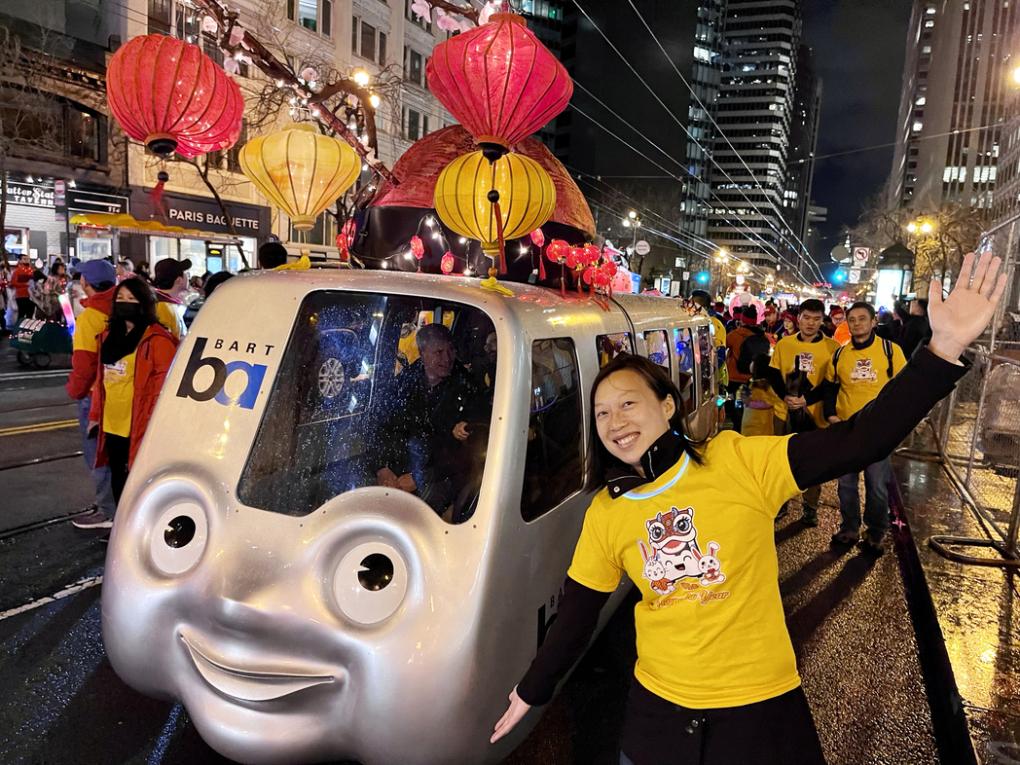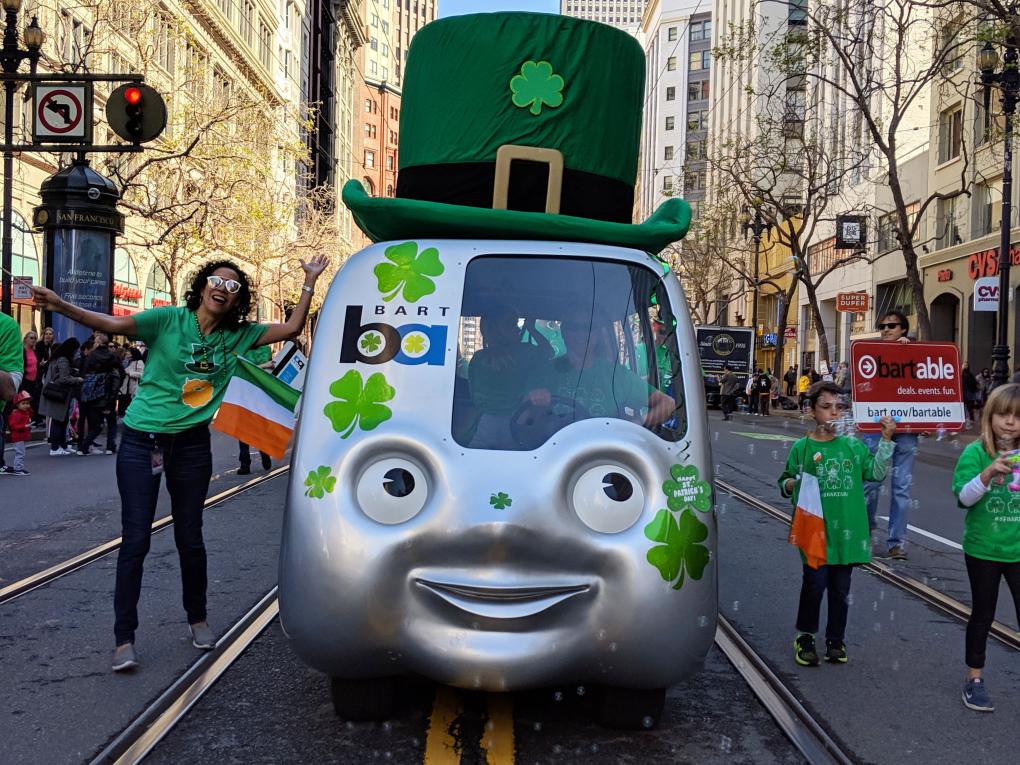The definitive history of the BARTmobile on its 20th birthday
Join us Saturday, July 27, at Orinda Station to toast the BARTmobile on chugging its way to 20 years. More event info here.
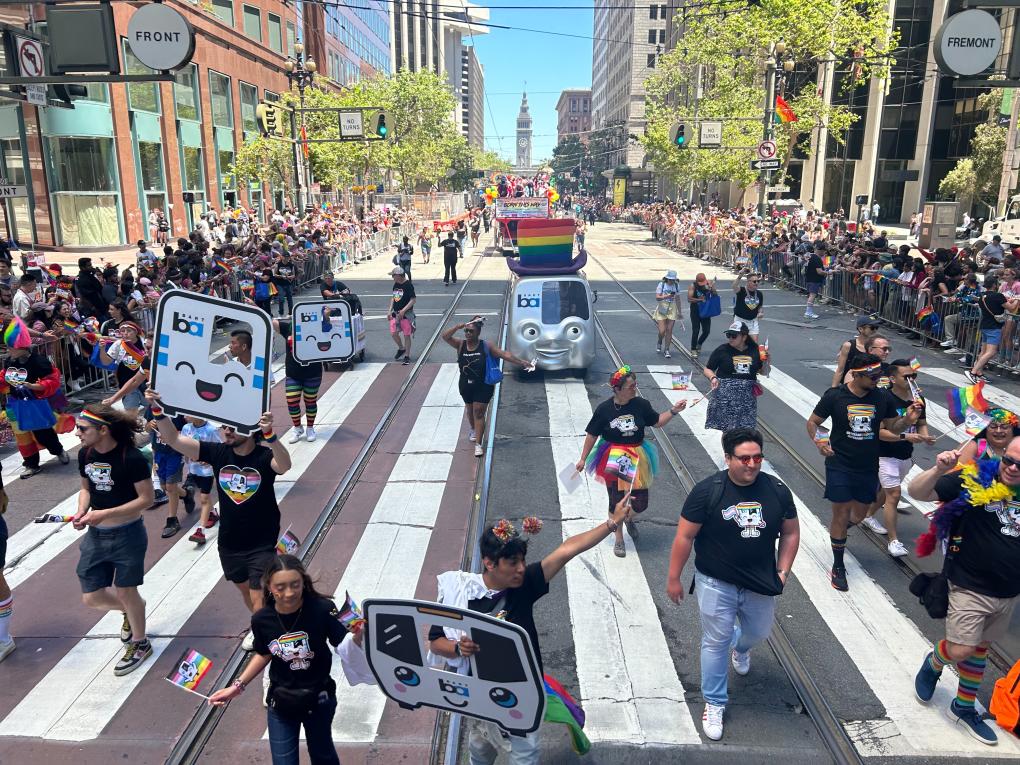
The BARTmobile in the 2024 San Francisco Pride Parade. Watch the parade from the BARTmobile's perspective on Instagram.
It has been said that its eyes can see through to your soul. Some have speculated it has the power to improve society. Those who cross its path are known to start acting joyfully and sometimes erratically. It’s even slowed traffic on the Bay Bridge.
If you have found yourself at a major Bay Area parade in the last two decades, chances are high you’ve encountered this mystical being, known as the BARTmobile.
The BARTmobile inspires in passersby what some may deem insane behavior. As it rolls down its given route, paradegoers will scream and shout at the anthropomorphic train as if it were Taylor Swift – “The BARTmobile is here! The BARTmobile is here!” In many instances, adults and children alike will dig through their wallets and pull out their Clipper cards, waving them maniacally at the BARTmobile’s smiling face as it rolls by.
But what exactly is the BARTmobile? And how did it come to have such a hold on the hearts and minds of Bay Area residents?
Jill Buschini, Principal Marketing Representative at BART, has been the official “BARTmobile wrangler” for the past eight parade seasons. She ensures the mobile gets where it needs to go for its bevy of local engagements. (Note: The BARTmobile currently participates only in major Bay Area parades and festivals.)
“When the BARTmobile arrives anywhere, the attention it gets still astounds me. It's incredibly fun to see and be part of!” said Buschini. “Kids and adults alike are transfixed by the small BART train with a face.”
Buschini said even the Golden State Warriors, during their 2022 Warriors Championship Parade, pointed and cheered at the BARTmobile when it caught their eye along the parade route.
There are a handful of crafty, ingenious folks responsible for birthing the BARTmobile. But there is one man responsible for kicking things off. That would be Doug Bartlett, a now-retired BART Principal Marketing Representative.
“Basically, anything that wasn’t normal BART marketing business was thrown to me,” Bartlett said, speaking by phone recently.
In the early 2000s, Bartlett arranged for a series of BART appearances in local parades and happenings. At that time, the Buildings and Grounds department lent BART paradegoers a few logo-emblazoned trucks to walk beside.
“The vehicles were obviously gas-powered,” Bartlett said. “It didn’t seem right. BART is electric!”
The BARTmobile by the Numbers
Weight | Height | Width | Length | Max Load | Max Speed | Battery | Seats |
704 lbs | 6 feet | 5 feet | 14 feet | 1,500 lbs | 15 mph | 12 Volts | 8 |
As a temporary solution, Bartlett began renting three-wheelers. They didn’t really have anything to do with BART, but they were electric, at least.
Then, Bartlett attended an Oakland Athletics game at the Coliseum. At the game, the team had golfcart-sized Chevron cars on display, as well as miniature cars to give to children. A switch flipped in Bartlett’s mind: “I said, ‘We should do this with a BARTmobile.’”
From that day forward, Bartlett set out to make the most fantastical, most adorable, most kid friendly BARTmobile possible.
“The justification was, my god, the San Francisco Gay Pride Parade is seen by more than one million people, just for starters,” Bartlett said. “In one year, a BARTmobile could be seen by more than five million people. It could obviously be justified from a marketing perspective.”
The wheels truly began turning on Halloween 2001, when the Commuter Check Service Corporation, a pre-tax commuter benefit solutions provider, agreed to donate $75,000 to cover the cost needed to construct the entirely electric BARTmobile, as well as a trailer and storage container for it to call home.

Initial concept sketches for the face of the BARTmobile by David Yee.
With funding secured, the design process began. First, playwright and carpenter Tony Pelligrino sculpted a model. Then, designer David Yee created initial sketches and concept art, trying to determine the right face for the roving mascot.
“Some of these drawings were the coolest I’d ever seen in my life -- think ‘Star Wars’ meets Tesla,” Bartlett remembered. “It was nuts! But at the same time, we had to dial it in to make it really look like a BARTmobile.”
Bartlett said the design team went “more for the character, the softness, the cuteness.”
“I wanted future BART riders to look at this as if BART has a personality,” Bartlett said. “We went through many iterations trying to get that face to look happy, but not strange. Some of the drawings were absolutely demonic – like Chucky leading the BARTmobile.”
Bartlett eventually connected with Charlie Bailey of Industrial Light and Magic, the Marin-based visual effects company founded by George Lucas in the 1970s.
“At the time [Bailey] was building the BARTmobile, his crew was building a massive ship for the ‘Pirates of the Caribbean’ movie. It was like 40 feet long!” Bartlett remembered.
Bailey and his colleague Mark Anderson, of the freelance Bailey Design Services team, built the BARTmobile on nights and weekends out of Anderson’s garage. First, they sculpted the face and the rear of the train out of foam and built the middle section from plywood and polyurethanes. They then painted the model and made a mold of the train, which was used to create the fiberglass body. Inspiration for the shape and style of the BARTmobile came from 1958 VW buses and Corvette concept cars.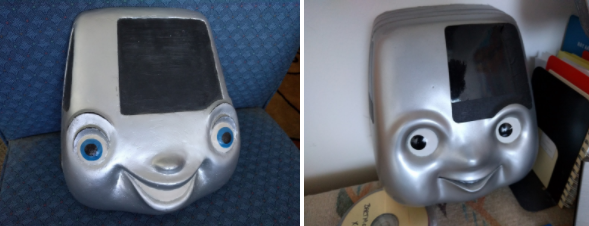
At some point, Anderson and Bailey – who could not be reached for comment – purchased an eight-seater golf cart from Bay Area Golf Carts, which they reinforced with steel. Finally, they built a steel chassis and secured the fiberglass body atop the cart. The last step: painting the BARTmobile with blue bumper strips and Chrysler silver.
Then came the electrical wiring. According to Bartlett, the same Industrial Light and Magic team that worked on “Star Wars” designed and installed the BARTmobile’s electronics. They even converted an actual BART train horn to run on 12-volt battery for the friendly faced vehicle.
“Generally speaking, we had all these incredible guys who oddly loved this project,” Bartlett said. “It was something so different. It was a challenge. And unlike a lot of their projects, it would be around for years to come.”
Bartlett is a musician – he said his current music project is making tunes for robots and aliens – so he was “obsessed” with equipping the BARTmobile with “giant speakers and a monster amp.” Today, he is proud to say that the BARTmobile’s sound system “will rattle your bones” at full throttle, thanks in part to a subwoofer that’s the size of an entire bench – a “must have” for Bartlett.
If you’ve ever witnessed the BARTmobile in a local parade, you will certainly have noticed its “outfits.” The mascot has a variety of specially constructed hats that it wears depending on the occasion: a top hat with rotating “skins” for St. Patrick’s Day, July Fourth, Pride, and the holiday season; a Lunar New Year hat; a Carmen Miranda hat (complete with giant fruit); and a baseball cap for sporting events.

A foam sculpture of the BARTmobile face.
The hats, like all things BARTmobile, have a story of their own. They were made by a team of crafty, creative individuals at Scientific Art Studio, a design and fabrication studio in Richmond that creates everything from museum exhibits to playgrounds and sculptures.
“The BARTmobile was one of those things,” said Ron Holthuysen, the Creative Director and Owner of Scientific Art Studio. “We had a hard time saying no [to the project]. When somebody comes to us, we typically say, ‘Oh yeah, we can do that.’”
To create the hats, Holthuysen began by drawing some concepts. Then, it was a matter of finding the right materials that were “lightweight but also durable,” said Gordon Glasgow, Shop Manager at Scientific Art Studio.
Once they found the materials – they range from heavy cotton to a “very fancy” silk brocade – Glasgow began crafting patterns as well as foam inner structures that would ensure the hats kept their shape and wouldn’t break. What couldn’t be found in stores, the designers made themselves.
“We do basically everything [at Scientific Art Studio],” Holthuysen said. “That’s how we ended up doing BARTmobile hats.”
Construction of the BARTmobile completed in February of 2004. The mascot was unveiled shortly thereafter with a “birthday party,” intended to attract “visibility for marketing programs to gain riders,” according to the run-of-show document for the day. A fife and drum corps kicked off the celebration, which also featured a birthday cake, train-themed CDs (it was the early 2000s after all), and toy train giveaways.
Since then, the BARTmobile has appeared at a multitude of events, driven over 250 miles, and seen by millions of people. To use Bartlett’s phrasing, the mobile has indelibly “put a face on BART.”



Initial concept sketches for the BARTmobile.
But the BARTmobile would never be seen in public were it not for its army of “handlers” – the BART workers who prepare and transport it to its multitude of engagements.
“I started working at BART in 2018. Since then, every time there’s a parade, I’m trying to get on [BARTmobile duty],” said Tomasz Radzikowski, Buildings Worker. Radzikowski estimates he’s delivered the mobile from its home, in BART’s Oakland Shop Annex, to local events at least six times.
“It’s a very exciting thing to do,” he said. “I like it – no, I love it.”
To prepare the BARTmobile for an event, one team of BART workers polish the chassis, charge the electronics, and soundcheck the stereo. This crew is also in charge of decorating, as well as dressing the BARTmobile in its event-specific hat.
From there, a second team loads and secures the BARTmobile on a special trailer. They’ll drive it from the Oakland Shop Annex to wherever it needs to appear that day and unload the 700-pound vehicle. At the end of the event, the process repeats itself in reverse.
“Whenever we drive from the Oakland shops to the city, people will wave at us and ask us to pull over to take pictures,” Radzikowski said. “Sometimes, people on the Bay Bridge will slow down because they’re so excited to see it.”
Radzikowski often hangs around the parade until it’s time to pack the BARTmobile back up. He said the joy and energy from the crowd when they see the mobile rolling down the street is palpable.
“You can see the good vibes and happiness,” he said. “It’s a beautiful feeling to experience.”
